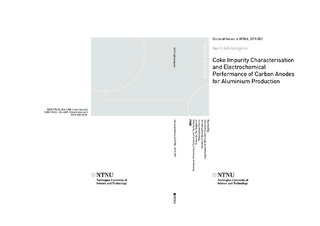| dc.contributor.advisor | Svensson, Ann Mari | |
| dc.contributor.advisor | Lossius, Petter | |
| dc.contributor.advisor | Ratvik, Arne Petter | |
| dc.contributor.author | Jahrsengene, Gøril | |
| dc.date.accessioned | 2020-01-30T07:29:06Z | |
| dc.date.available | 2020-01-30T07:29:06Z | |
| dc.date.issued | 2019 | |
| dc.identifier.isbn | 978-82-326-4301-1 | |
| dc.identifier.issn | 1503-8181 | |
| dc.identifier.uri | http://hdl.handle.net/11250/2638717 | |
| dc.description.abstract | The aluminium production process uses consumable carbon anodes made from calcined petroleum cokes, recycled anode butts and coal tar pitch. The main ingredient is the coke, a side product from the petroleum refining industry. Declining coke quality of the cokes available for aluminium production is a consequence of changes in the petroleum industry and the high demand from the still growing aluminium industry. In the future, regular anode grade cokes, or sponge cokes, with more impurities, mainly sulfur, phosphorous and metals, as well as isotropic cokes, will have to be used to produce anodes.
X-ray absorption near edge structure (XANES) and extended X-ray absorption fine structure (EXAFS) on the metals V, Ni, and Fe, in industrially produced petroleum cokes, revealed that these metals are present as hexagonal metal sulfide compounds. The metal sulfides are likely highly dispersed in the coke and not present as inclusions, and the metal chemistry was the same in all cokes investigated. Sulfur XANES found S bound organically as polycyclic thiophene and thiazines as a part of the carbon sheets as the main sulfur compounds in all cokes investigated. However, in some cokes, independent of total sulfur level, a large fraction of the sulfur was clearly a different compound, which has not previously been observed in these quantities in cokes. The amounts of this sulfur, a S-S bound sulfide, was found to correlate to both CO2 reactivity and quantity of small pores in the coke.
Electrochemical characterisation on pilot anodes made from the well-characterised cokes showed that reaction overpotential was of similar magnitude for all anisotropic anodes. The isotropic anode had higher double layer capacitance, a measure of the electrochemically active surface area, improved kinetics and a slightly lower reaction overpotential compared to the anisotropic anodes. A significant reduction, around 0.15 V, in potential amplitude associated with the formation of CO2 bubbles on the anode surface, was observed for the isotropic anode, but also for the low-sulfur anisotropic anode. The last observation was attributed to the higher permeability, higher porosity and larger pores on the surface of this specific pilot anode. No significant differences in overpotential or bubble behaviour was observed for anodes varying in impurity content with similar physical properties. The impurities, both sulfur and metals, did in this case not affect the electrochemical processes, which is a positive outlook regarding the use of more impure cokes in the future. | nb_NO |
| dc.language.iso | eng | nb_NO |
| dc.publisher | NTNU | nb_NO |
| dc.relation.ispartofseries | Doctoral theses at NTNU;2019:352 | |
| dc.relation.haspart | Paper 1: Jahrsengene, Gøril; Wells, Hannah C.; Rørvik, Stein; Ratvik, Arne Petter; Haverkamp, Richard G.; Svensson, Ann Mari. A XANES study of sulfur speciation and reactivity in cokes for anodes used in aluminum production. Metallurgical and materials transactions. B, process metallurgy and materials processing science 2018 ;Volum 49.(3) s. 1434-1443
https://doi.org/10.1007/s11663-018-1215-x
This is an open access article distributed under the terms of the Creative Commons CC BY | nb_NO |
| dc.relation.haspart | Paper 2: Jahrsengene, Gøril; Rørvik, Stein; Ratvik, Arne Petter; Lossius, Lorentz Petter; Haverkamp, Richard G.; Svensson, Ann Mari. Reactivity of coke in relation to sulfur level and microstructure. The Minerals, Metals & Materials Series 2019 s. 1247-1253
https://doi.org/10.1007/978-3-030-05864-7_153 | nb_NO |
| dc.relation.haspart | Paper 3: Jahrsengene, Gøril; Wells, Hannah C.; Sommerseth, Camilla; Ratvik, Arne Petter; Lossius, Lorentz Petter; Sizeland, Katie H.; Kappen, Peter; Svensson, Ann Mari; Haverkamp, Richard G.. An EXAFS and XANES study of V, Ni, and Fe speciation in cokes for anodes used in aluminum production. Metallurgical and materials transactions. B, process metallurgy and materials processing science 2019 ;Volum 50.(6) s. 2969-2981
https://doi.org/10.1007/s11663-019-01676-z | nb_NO |
| dc.relation.haspart | Paper 4:
Jahrsengene, Gøril; Ratvik, Arne Petter; Lossius, Lorentz Petter; Svensson, Ann Mari;
Electrochemical Characterisation of Anodes for the Aluminium Industry made from Cokes with Variable Impurity | nb_NO |
| dc.title | Coke Impurity Characterisation and Electrochemical Performance of Carbon Anodes for Aluminium Production | nb_NO |
| dc.type | Doctoral thesis | nb_NO |
| dc.subject.nsi | VDP::Technology: 500::Materials science and engineering: 520 | nb_NO |
